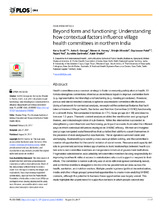| dc.contributor.author | Scott, Kerry | |
| dc.contributor.author | George, Asha S. | |
| dc.contributor.author | Harvey, Steven A. | |
| dc.contributor.author | Mondal, Shinjini | |
| dc.contributor.author | Patel, Gupteswar | |
| dc.contributor.author | Ved, Rajani | |
| dc.contributor.author | Garimella, Surekha | |
| dc.contributor.author | Sheikh, Kabir | |
| dc.date.accessioned | 2018-10-29T12:24:34Z | |
| dc.date.available | 2018-10-29T12:24:34Z | |
| dc.date.issued | 2017 | |
| dc.identifier.citation | Scott, K. et al. (2017). Beyond form and functioning: Understanding how contextual factors influence village health committees in northern India. PLoS ONE, 12(8): e0182982. | en_US |
| dc.identifier.issn | 1932-6203 | |
| dc.identifier.uri | https://doi.org/ 10.1371/journal.pone.0182982 | |
| dc.identifier.uri | http://hdl.handle.net/10566/4165 | |
| dc.description.abstract | Health committees are a common strategy to foster community participation in health. Efforts
to strengthen committees often focus on technical inputs to improve committee form
(e.g. representative membership) and functioning (e.g. meeting procedures). However,
porous and interconnected contextual spheres also mediate committee effectiveness.
Using a framework for contextual analysis, we explored the contextual features that facilitated
or hindered Village Health, Sanitation and Nutrition Committee (VHSNC) functionality
in rural north India. We conducted interviews (n = 74), focus groups (n = 18) and observation
over 1.5 years. Thematic content analysis enabled the identification and grouping of
themes, and detailed exploration of sub-themes. While the intervention succeeded in
strengthening committee form and functioning, participant accounts illuminated the different
ways in which contextual influences impinged on VHSNC efficacy. Women and marginalized
groups navigated social hierarchies that curtailed their ability to assert themselves in
the presence of men and powerful local families. These dynamics were not static and
unchanging, illustrated by pre-existing cross-caste problem solving, and the committee's
creation of opportunities for the careful violation of social norms. Resource and capacity deficits
in government services limited opportunities to build relationships between health system
actors and committee members and engendered mistrust of government institutions.
Fragmented administrative accountability left committee members bearing responsibility for
improving local health without access to stakeholders who could support or respond to their
efforts. The committee's narrow authority was at odds with widespread community needs,
and committee members struggled to involve diverse government services across the
health, sanitation, and nutrition sectors. Multiple parallel systems (political decentralization,
media and other village groups) presented opportunities to create more enabling VHSNC
contexts, although the potential to harness these opportunities was largely unmet. This
study highlights the urgent need for supportive contexts in which people can not only participate in health committees, but also access the power and resources needed to bring
about actual improvements to their health and wellbeing. | en_US |
| dc.language.iso | en | en_US |
| dc.publisher | Public Library of Science | en_US |
| dc.rights | © 2017 Scott et al. This is an open
access article distributed under the terms of the
Creative Commons Attribution License, which
permits unrestricted use, distribution, and
reproduction in any medium, provided the original
author and source are credited. | |
| dc.subject | Health committees | en_US |
| dc.subject | Community participation | en_US |
| dc.subject | Health | en_US |
| dc.subject | Village Health, Sanitation and Nutrition Committee (VHSNC) | en_US |
| dc.title | Beyond form and functioning: Understanding how contextual factors influence village health committees in northern India | en_US |
| dc.type | Article | en_US |
| dc.privacy.showsubmitter | FALSE | |
| dc.status.ispeerreviewed | TRUE | |
| dc.description.accreditation | ISI | |

